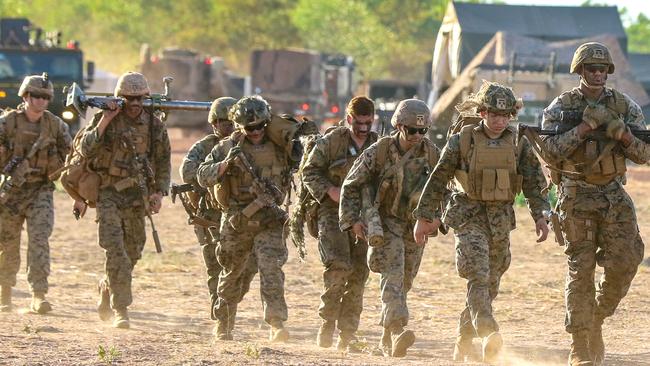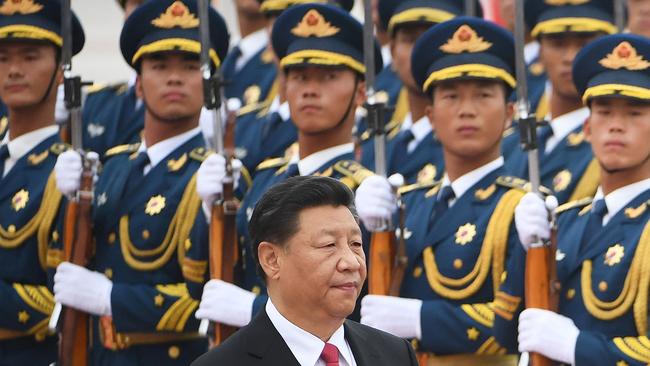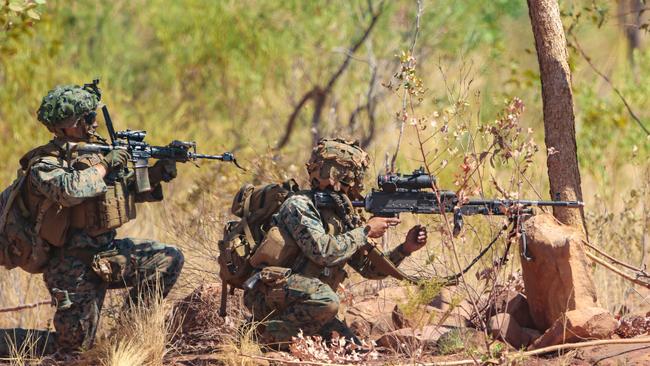Pentagon plans to improve bases in Guam and Australia to confront China
A Pentagon review of its global military resources plans improvements to airfields and other infrastructure in its Australian military base to counter China’s military build-up.

A Pentagon review of military resources worldwide plans improvements to bases in Guam and Australia to counter China but contains no major reshuffling of US forces to take on Beijing while deterring Russia and fighting terrorism in the Middle East and Africa.
The review, an unclassified version of which is due to be released later Monday, aims to sharpen the link between U.S.’s vast military capabilities and the Biden administration’s strategic priorities — countering China’s military build-up and more assertive use of power chief among them.
Known as the global posture review, the assessment — whose results haven’t been previously reported — plans for improvements to the airfields and other infrastructure at U.S. bases in Guam and Australia, defence officials said.
While some details about the repositioning of military capabilities are classified and others have been previously announced, defence specialists said the review’s lack of sizeable adjustments to military forces in Asia shows the challenges the U.S. faces in rebalancing resources to confront China while maintaining other global commitments.

In the 10 months since President Biden took office, his administration conducted a chaotic end to the U.S. war in Afghanistan and has faced Moscow’s military threats against Ukraine, including a current build-up of Russian troops that U.S. officials said may be a prelude to invasion. China has meanwhile stepped up military intimidation of Taiwan, a U.S. partner.
“The world is even more unsteady than six months ago,” said Mackenzie Eaglen, a senior fellow and specialist in defence strategy at the conservative American Enterprise Institute.
The pullout from Afghanistan in particular, Ms. Eaglen said, means the U.S. must monitor for terrorism threats and collect intelligence from farther away, making it difficult to shift resources. “That’s part of the reason you can’t significantly change force posture in the Middle East and Europe, because we lost our eyes in Afghanistan,” she said.
The global outlook is fluid, a senior defence official said, but the review achieved some of its objectives, especially on China.
“The more you look at any given region, the more complicated the region becomes,” the official said. “But I do think we were able to make some decisions through this that really reinforced our commitment to getting after the Indo-Pacific,” the official said. “We’ve moved the needle.” The Pentagon review was begun under Defence Secretary Lloyd Austin earlier this year and is one of several national-security and defence-policy blueprints the Biden administration is expected to release in coming months.

Force posture in the Middle East, Europe and Africa will continue to be analysed, the official and others in the Pentagon said. Afghanistan underwent a separate interagency review, they said, and cyber and nuclear capabilities are also being reviewed under separate initiatives. A China-specific review, of which much of the results are classified, was completed earlier this year.
Another senior defence official said that, despite expectations that it would result in strategic changes, the global posture review didn’t find a need for large adjustments. More changes may follow a new national-defence strategy due early next year, the official said.
“There was a sense at the outset that there was a potential for some major force posture changes,” said the official. “Then, as we got deeper and deeper into the work, we realised in the aggregate that the force posture around the world was about right.” The infrastructure improvements touted in the review’s unclassified version will begin in coming weeks in Guam, which hosts a large naval and Air Force contingent and thousands of American forces, and in Australia, where Marines deploy on a rotational basis. Both are key in Washington’s strategy to counter China, officials said.

Improvements to airfields in Guam and Australia will expand the ability of the U.S. to ferry troops in and out of the area for deployments or in the event of a conflict, they said.
The officials declined to provide additional specifics on the improvements, saying they were classified.
Some shifting of troops or capabilities associated with the review and in keeping with the current strategy have already been announced or have occurred, the officials said.
Those include deployments of aircraft and logistics capabilities to Australia and a permanent deployment of an attack helicopter squadron and an artillery division headquarters in South Korea.

In Europe, Pentagon officials earlier removed a cap of 25,000 U.S. troops that could be assigned to Germany announced last year by Trump administration officials.
Defence officials have also notified Belgium and Germany that the U.S. would maintain its presence at seven sites previously marked for return to their host nations under a base-consolidation plan.
In June, The Wall Street Journal reported that the Pentagon was removing eight Patriot antimissile systems from the Middle East in a major realignment of its military presence in the region.
The Patriot systems, which were used to defend U.S. forces and other military capabilities, like jet fighter squadrons, were removed because they were no longer needed as some of the military forces were pulled out, officials said. Many defence specialists and some military officials say the removal of military capabilities in the region sent a sign to Gulf allies and others that the U.S. isn’t committed to the region.
Mr. Austin, in the United Arab Emirates and Bahrain last week, attempted to reassure countries in the region. “America’s commitment to security in the Middle East is strong and secure,” Mr. Austin said at a security forum in Bahrain.
Dow Jones







To join the conversation, please log in. Don't have an account? Register
Join the conversation, you are commenting as Logout